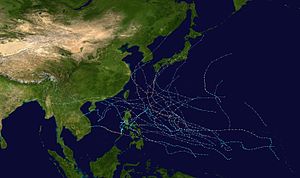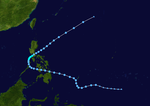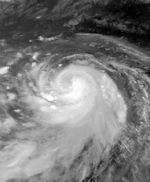Tropical Storm Roger (Sisang)
| 1979 Pacific typhoon season | |
|---|---|

Season summary map
|
|
| Seasonal boundaries | |
| First system formed | March 19, 1979 |
| Last system dissipated | December 23, 1979 |
| Strongest storm | |
| Name | Tip (Most intense tropical cyclone ever recorded) |
| • Maximum winds | 260 km/h (160 mph) (10-minute sustained) |
| • Lowest pressure | 870 hPa (mbar) |
| Seasonal statistics | |
| Total depressions | 54 |
| Total storms | 24 |
| Typhoons | 12 |
| Super typhoons | 4 (Unofficial) |
| Total fatalities | > 541 |
| Total damage | Unknown |
| Related articles | |
| Typhoon (JMA) | |
| Category 2 typhoon (SSHWS) | |
| Duration | March 19 – March 25 |
|---|---|
| Peak intensity | 130 km/h (80 mph) (10-min) 955 hPa (mbar) |
| Typhoon (JMA) | |
| Category 1 typhoon (SSHWS) | |
| Duration | April 10 – April 20 |
|---|---|
| Peak intensity | 140 km/h (85 mph) (10-min) 965 hPa (mbar) |
| Tropical storm (JMA) | |
| Tropical storm (SSHWS) | |
| Duration | May 9 – May 17 |
|---|---|
| Peak intensity | 75 km/h (45 mph) (10-min) 985 hPa (mbar) |
| Tropical storm (JMA) | |
| Tropical depression (SSHWS) | |
| Duration | May 17 – May 24 |
|---|---|
| Peak intensity | 75 km/h (45 mph) (10-min) 992 hPa (mbar) |
| Typhoon (JMA) | |
| Category 2 typhoon (SSHWS) | |
| Duration | June 29 – July 7 |
|---|---|
| Peak intensity | 140 km/h (85 mph) (10-min) 955 hPa (mbar) |
| Severe tropical storm (JMA) | |
| Tropical storm (SSHWS) | |
| Duration | July 1 – July 9 |
|---|---|
| Peak intensity | 100 km/h (65 mph) (10-min) 990 hPa (mbar) |
| Tropical depression (SSHWS) | |
| Duration | July 23 – July 27 |
|---|---|
| Peak intensity | 35 km/h (25 mph) (1-min) 1005 hPa (mbar) |
| Typhoon (JMA) | |
| Category 4 super typhoon (SSHWS) | |
| Duration | July 24 – August 8 |
|---|---|
| Peak intensity | 205 km/h (125 mph) (10-min) 900 hPa (mbar) |
| Severe tropical storm (JMA) | |
| Tropical storm (SSHWS) | |
| Duration | July 25 – July 31 |
|---|---|
| Peak intensity | 100 km/h (65 mph) (10-min) 975 hPa (mbar) |
The 1979 Pacific typhoon season has no official bounds; it ran year-round in 1979, but most tropical cyclones tend to form in the northwestern Pacific Ocean between June and December. These dates conventionally delimit the period of each year when most tropical cyclones form in the northwestern Pacific Ocean.
The scope of this article is limited to the Pacific Ocean, north of the equator and west of the international date line. Storms that form east of the date line and north of the equator are called hurricanes; see 1979 Pacific hurricane season. Tropical storms formed in the entire west Pacific basin were assigned a name by the Joint Typhoon Warning Center. Tropical depressions in this basin have the "W" suffix added to their number. Tropical depressions that enter or form in the Philippine area of responsibility are assigned a name by the Philippine Atmospheric, Geophysical and Astronomical Services Administration or PAGASA. This can often result in the same storm having two names.
28 tropical depressions formed this year in the Western Pacific, of which 24 became tropical storms. 13 storms reached typhoon intensity, of which 4 reached super typhoon strength.
Typhoon Bess was the third typhoon since 1959 to develop in the month of March. Bess began as a weak surface circulation on March 16. The circulation intensified into a tropical depression on March 19. Bess then reached tropical storm strength on March 21. Slow intensification occurred for 18 hours, before Bess reached its peak intensity of 105 mph (165 km/h) early on March 23. Bess held on to its peak intensity for 18 hours before vertical wind shear caused Bess to rapidly dissipate on March 25. Typhoon Bess remained away from land, and therefore caused no deaths or damage.
Typhoon Cecil formed on the 10th from an easterly wave in early April. The storm then reached its maximum intensity as a category 1 typhoon on the 14th. Typhoon Cecil then dissipated on April 20. Typhoon Cecil stuck Leyte on April 15, causing 18 deaths, damage of $10 million and leaving 8,900 homeless. Cecil was also the first tropical cyclone in the Western Pacific to be given a male name.
A tropical disturbance developed on May 6. By May 10, the disturbance was upgraded to a tropical depression. It then was upgraded to a tropical storm on May 11. Dot then reached its peak intensity as a weak tropical storm the next day. Dot was downgraded to a tropical depression late on the 14th. The storm dissipated on May 17.
...
Wikipedia


















